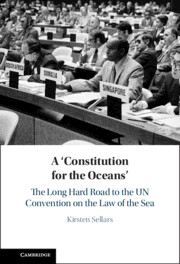
-
Select format
-
- Publisher:
- Cambridge University Press
- Publication date:
- February 2025
- February 2025
- ISBN:
- 9781108879040
- 9781108840149
- Dimensions:
- (228 x 152 mm)
- Weight & Pages:
- 0.68kg, 372 Pages
- Dimensions:
- Weight & Pages:
You may already have access via personal or institutional login
Book description
The UN Convention on the Law of the Sea, signed in 1982, was the culmination of half a century of legal endeavour. Earlier attempts to create a treaty regime governing the ocean — at League of Nations and United Nations conferences in 1930, 1958 and 1960 — had all failed to settle the breadth of the territorial sea, and in two cases failed to settle anything at all. During the negotiations, legal concepts were formulated and reformulated: straight baselines inspired archipelagic baselines; fishing conservation zones became exclusive economic zones; innocent passage through straits metamorphosed into transit passage through straits; and the seabed common heritage was replaced by the parallel system of seabed exploitation. Many of the issues that animated the delegates during the negotiations — ocean pollution, over-fishing, naval mobility, continental shelf claims and the impact of seabed mining — continue to exercise policymakers and lawyers to this day.
Contents
Metrics
Full text views
Full text views help Loading metrics...
Loading metrics...
* Views captured on Cambridge Core between #date#. This data will be updated every 24 hours.
Usage data cannot currently be displayed.
Accessibility standard: Unknown
Why this information is here
This section outlines the accessibility features of this content - including support for screen readers, full keyboard navigation and high-contrast display options. This may not be relevant for you.
Accessibility Information
Accessibility compliance for the PDF of this book is currently unknown and may be updated in the future.

